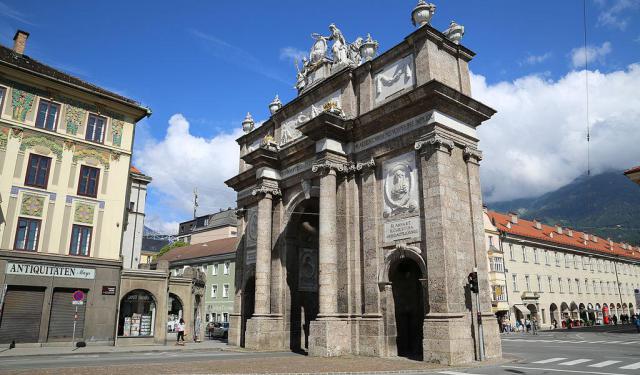Ottoburg (Otto Castle), Innsbruck
In the picturesque city of Innsbruck, nestled within the majestic Tyrolean Alps, lies a historic gem that marries the natural beauty of its surroundings with a rich tapestry of history: the Ottoburg, also known as Otto Castle. This medieval fortress, transformed into a restaurant, invites visitors to embark on a captivating journey through Austria's illustrious past, offering an experience that transcends the mere act of dining.
Constructed around the year 1494 during the reign of Emperor Maximilian I, the Ottoburg was initially erected as part of a strategic effort to fortify Innsbruck against potential invasions. Its name is derived from Otto Henry, the Archduke of Austria, who later became King of Bohemia and Hungary and briefly resided within its walls. Over the centuries, the castle has been a silent witness to the unfolding of historical events, standing as a testament to the region's vibrant history.
Originally serving as a defensive tower, the Ottoburg was designed to protect the city from external threats. However, as time progressed, it underwent several transformations, evolving from a military bastion to a residential building, and eventually to its current incarnation as a renowned restaurant that prides itself on offering exquisite Austrian cuisine. This series of transformations reflects the adaptability and resilience of the structure through the ages.
The Ottoburg's architecture is a captivating blend of styles from different eras, reflecting its history of renovations. Its foundation boasts original Gothic elements, while Renaissance touches adorn the upper levels, added during refurbishments in the 16th century for residential purposes. The fortress's sturdy construction is apparent in its thick river-stone walls at the base, transitioning to brickwork above, showcasing its evolution through various construction phases.
Today, the historic Ottoburg houses one of Innsbruck's most distinguished restaurants. Entering Restaurant Ottoburg is akin to stepping through a portal into the past, with interiors that have been meticulously preserved to maintain their historic allure. The restaurant's ambiance is enriched by antique wooden furnishings and traditional Tyrolean décor, offering guests a unique dining experience that combines the warmth of Austrian hospitality with the charm of historical splendor.
Constructed around the year 1494 during the reign of Emperor Maximilian I, the Ottoburg was initially erected as part of a strategic effort to fortify Innsbruck against potential invasions. Its name is derived from Otto Henry, the Archduke of Austria, who later became King of Bohemia and Hungary and briefly resided within its walls. Over the centuries, the castle has been a silent witness to the unfolding of historical events, standing as a testament to the region's vibrant history.
Originally serving as a defensive tower, the Ottoburg was designed to protect the city from external threats. However, as time progressed, it underwent several transformations, evolving from a military bastion to a residential building, and eventually to its current incarnation as a renowned restaurant that prides itself on offering exquisite Austrian cuisine. This series of transformations reflects the adaptability and resilience of the structure through the ages.
The Ottoburg's architecture is a captivating blend of styles from different eras, reflecting its history of renovations. Its foundation boasts original Gothic elements, while Renaissance touches adorn the upper levels, added during refurbishments in the 16th century for residential purposes. The fortress's sturdy construction is apparent in its thick river-stone walls at the base, transitioning to brickwork above, showcasing its evolution through various construction phases.
Today, the historic Ottoburg houses one of Innsbruck's most distinguished restaurants. Entering Restaurant Ottoburg is akin to stepping through a portal into the past, with interiors that have been meticulously preserved to maintain their historic allure. The restaurant's ambiance is enriched by antique wooden furnishings and traditional Tyrolean décor, offering guests a unique dining experience that combines the warmth of Austrian hospitality with the charm of historical splendor.
Want to visit this sight? Check out these Self-Guided Walking Tours in Innsbruck. Alternatively, you can download the mobile app "GPSmyCity: Walks in 1K+ Cities" from Apple App Store or Google Play Store. The app turns your mobile device to a personal tour guide and it works offline, so no data plan is needed when traveling abroad.
Ottoburg (Otto Castle) on Map
Sight Name: Ottoburg (Otto Castle)
Sight Location: Innsbruck, Austria (See walking tours in Innsbruck)
Sight Type: Attraction/Landmark
Guide(s) Containing This Sight:
Sight Location: Innsbruck, Austria (See walking tours in Innsbruck)
Sight Type: Attraction/Landmark
Guide(s) Containing This Sight:
Walking Tours in Innsbruck, Austria
Create Your Own Walk in Innsbruck
Creating your own self-guided walk in Innsbruck is easy and fun. Choose the city attractions that you want to see and a walk route map will be created just for you. You can even set your hotel as the start point of the walk.
Innsbruck's Architectural Jewels
Coveted by empires, republics and ruling dynasties over the centuries, Innsbruck has been a living treasure house of history and culture. Undoubtedly this is one of Europe's most idyllic cities, nestled amid the craggy peaks in the heart of the Austrian Alps. Innsbruck equally scores as an Alpine playground and a showcase for Hapsburg imperial heritage, and is famous for its ancient,... view more
Tour Duration: 1 Hour(s)
Travel Distance: 1.4 Km or 0.9 Miles
Tour Duration: 1 Hour(s)
Travel Distance: 1.4 Km or 0.9 Miles
Innsbruck Introduction Walking Tour
Innsbruck is the capital of Tyrol, Austria. It lies in a broad valley on the river Inn, not far from the Brenner Pass. The name "Innsbruck" means "Bridge over the Inn." In the 4th century Romans established a military outpost there, calling it "Bridge over the Oeni" ("Oeni Pontum" in Latin).
In 1180 the Counts of Andechs took over the town. The Brenner... view more
Tour Duration: 1 Hour(s)
Travel Distance: 1.8 Km or 1.1 Miles
In 1180 the Counts of Andechs took over the town. The Brenner... view more
Tour Duration: 1 Hour(s)
Travel Distance: 1.8 Km or 1.1 Miles





